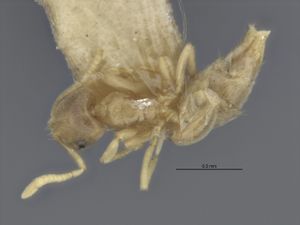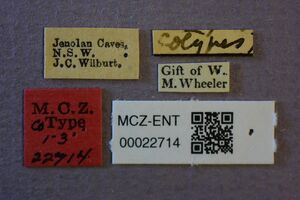Plagiolepis clarki
| Plagiolepis clarki | |
|---|---|

| |
| Scientific classification | |
| Kingdom: | Animalia |
| Phylum: | Arthropoda |
| Class: | Insecta |
| Order: | Hymenoptera |
| Family: | Formicidae |
| Subfamily: | Formicinae |
| Tribe: | Plagiolepidini |
| Genus: | Plagiolepis |
| Species: | P. clarki |
| Binomial name | |
| Plagiolepis clarki Wheeler, W.M., 1934 | |
| Synonyms | |
| |
Judging from the pale colouration and small eyes of the worker, have much the same hypogaeic habits as the species of Brachymyrmex of North and South America. (Wheeler 1934)
Identification
Distribution
Distribution based on Regional Taxon Lists
Australasian Region: Australia (type locality).
Distribution based on AntMaps
Distribution based on AntWeb specimens
Check data from AntWeb
Countries Occupied
| Number of countries occupied by this species based on AntWiki Regional Taxon Lists. In general, fewer countries occupied indicates a narrower range, while more countries indicates a more widespread species. |

|
Estimated Abundance
| Relative abundance based on number of AntMaps records per species (this species within the purple bar). Fewer records (to the left) indicates a less abundant/encountered species while more records (to the right) indicates more abundant/encountered species. |

|
Biology
Castes
   
| |
| Syntype of Plagiolepis impasta. . | Owned by Museum of Comparative Zoology. |
Nomenclature
The following information is derived from Barry Bolton's Online Catalogue of the Ants of the World.
- clarki. Plagiolepis clarki Wheeler, W.M. 1934d: 157 (w.q.m.) AUSTRALIA.
- impasta. Plagiolepis clarki subsp. impasta Wheeler, W.M. 1934d: 158 (w.) AUSTRALIA.
- Subspecies of clarki: Taylor & Brown, 1985: 130; Bolton, 1995b: 335.
- Junior synonym of clarki: Heterick, 2021: 18.
Unless otherwise noted the text for the remainder of this section is reported from the publication that includes the original description.
Type Material
Described from seven workers and fifteen males taken by Mr. John Clark at Mundaring Weir, Western Australia (type-locality), four workers from Margaret River (XI. 4, '31) and two colony-founding females from Pemberton (XI. 13, '31), taken by myself.
- Plagiolepis clarki: Syntype, 3 workers, Margaret River, Western Australia, Australia, Museum of Comparative Zoology.
- Plagiolepis clarki: Syntype, 4 workers, 9 males, Mundaring Weir, Western Australia, Australia, Museum of Comparative Zoology.
- Plagiolepis clarki: Syntype, 2 queens, Pemberton, Western Australia, Australia, Museum of Comparative Zoology.
- Plagiolepis clarki: Syntype, 3 males, Mundaring Weir, Western Australia, Australia, Western Australian Museum.
- Plagiolepis clarki impasta: Syntype, 3 workers, Jenolan Caves, Blue Mts., New South Wales, Australia, Museum of Comparative Zoology.
Taxonomic Notes
Heterick (2021): Plagiolepis clarki impasta was described by Wheeler from workers in Victoria based on quite trivial distinctions, and the Automontage pictures in AntWiki lead this author to believe this ant and P. clarki are one and the same.
Description
Worker
Length 1-1.5 mm.
Head subrectangular, slightly longer than broad, very nearly as broad in front as behind, with nearly straight posterior border and feebly convex sides. Eyes small, flat, near the middle of the sides, less than half as long as their distance from the anterior corners of the head, with only about seven facets in their longest diameter; ocelli very minute. Mandibles rather narrower and convex, 6-toothed, the first, fourth and sixth tooth larger, the fifth very minute. Clypeus short, convex but not carinate in the middle, its anterior border not projecting, broadly rounded and entire. Frontal area distinct, triangular, 10ngeT than broad; frontal groove shallow and rather indistinct. Antennae short; scapes reaching only to the posterior border of the head; funiculi enlarged at the tip; first joint large, as long as joints 2 to 4 together; 2 and 3 small and nearly twice as broad as long; 4 to 9 distinctly broader than long, the terminal joint as long as the four preceding together. Thorax short; pronotum nearly twice as broad as long, with sloping humeri; mesonotum convex, transversely elliptical, somewhat less than twice as broad as long; mesometanotal suture obsolete; metanotum very short and indistinct, its spiracles prominent, separated by a distance equal to about be times their diameter, metaepinotal suture very distinct; epinotum as broad as long, parallel-sided. In profile the anterior end of the pronotum rises steeply, its posterior end, the mesonotum and base of the epinotum forming a flat curve, with only a feeble impression at the metanotum, which is hidden in profile by the prominent spiracle; epinotum long and sloping, the base very short, not distinctly marked off from the declivity. Petiole with higher and less anteriorly inclined scale than in the two preceding species, cuneate in profile, flattened behind, anteriorly concave below and convex above, with sharp superior border, which from behind is broadly rounded, with straight, ventrally converging sides. Gaster large, oval, pointed posteriorly, its first segment bulging forward, overlying the petiole and with a deep impression for its accommodation. Legs rather stout.
Subopaque, somewhat lustrous or glossy; very finely and microscopically punctulate; clypeus smooth and shining; mandibles with elongate punctures.
Hairs and pubescence white, the former very sparse, erect or suberect, confined to the clypeus, the tip of the gaster and the posterior borders of its segments. Pubescence short, fine, appressed, moderately dense over the whole surface of the body and appendages and concealing the shining integument.
Brownish yellow or yellowish brown; mandibles, pal pi, clypeus, antennae and legs, including the coxae, pale yellow.
Queen
(dealated) Length 3 mm.
Head as broad as long and more rectangular than in the worker; eyes large, moderately convex, longer than their distance from the anterior corners, Antennal scapes extending a little beyond the posterior border of the head. Thorax large, broader than the head, about one and two-thirds longer than broad; mesonotum flattened above, one and one-third times broader than long, broadly arcuate in front, straight behind; epinotum with moderately convex base, which is about half as long as the declivity. Petiolar scale erect, cuneate in profile above, where it is compressed anteroposteriorly and curved backward, so that it is convex in front and concave behind, with acute superior border. From behind the latter is straight or slightly sinuate in the middle, with rounded sides.
Sculpture much as in the worker, but the mesonotum is smoother and more shining.
Pilosity and pubescence yellowish, the former as in the worker, the latter much longer and coarser, especially on the gaster.
Head, thorax and gaster brown, the gaster slightly paler; otherwise like the worker.
Male
Length 1.5-1.7 mill.
Head broader than long through the eyes, which are very convex and nearly half as long as the sides; cheeks about one third as long as the eyes, converging anteriorly; postocular portion of head rounded-subrectangular, more than twice as broad as long, with prominent, widely separated ocelli. MAndibles small, slender, falcate and edentate. Clypeus short, three times as broad as long, evenly convex, with nearly straight anterior border. Frontal area broader than long'; frontal groove very distinct. Antennae slender; scapes reaching a little beyond the posterior ocelli; funiculi gradually thickened distally; joints 2 and 3 slightly broader than long, 4 to 10 slightly longer than broad, 11 as long as the three preceding together. Thorax large, broader than the head; mesonotum subcircular, somewhat broader than long, anteriorly very convex and overarching the pronotum; flattened and horizontal posteriorly; epinotum convex, rather abruptly sloping, with indistinct base and declivity. Petiolar scale erect, small and very thin, with sharp superior border, from behind subrectangular, with straight superior border and rounded superior comers. Gaster elongate-elliptical. Stipites of genitalia narrow, triangular and pointed; volsellae slender, geniculate and deflected; sagittae large, flat, blade-shaped, their truncated tips terminating above in an acute point. Legs slender. Wings large and broad, with large peterostigma.
Sculpture and pilosity much as in the worker but the dorsal surface of the thorax and gaster more shining owing to the much sparser pubescence on these parts.
Colour like that of the worker, except that the head and thorax are brown and darker than the gaster; antennae and legs also darker than in the worker. Wings white, with white veins and pterostigma.
References
- Heterick, B.E. 2021. A guide to the ants of Western Australia. Part I: Systematics. Records of the Western Australian Museum, Supplement 86, 1-245 (doi:10.18195/issn.0313-122x.86.2021.001-245).
- Heterick, B.E. 2022. A guide to the ants of Western Australia. Part II: Distribution and biology. Records of the Western Australian Museum, supplement 86: 247-510 (doi:10.18195/issn.0313-122x.86.2022.247-510).
- Wheeler, W. M. 1934d. Contributions to the fauna of Rottnest Island, Western Australia. No. IX. The ants. J. R. Soc. West. Aust. 20: 137-163 (page 157, worker, queen, male described)

